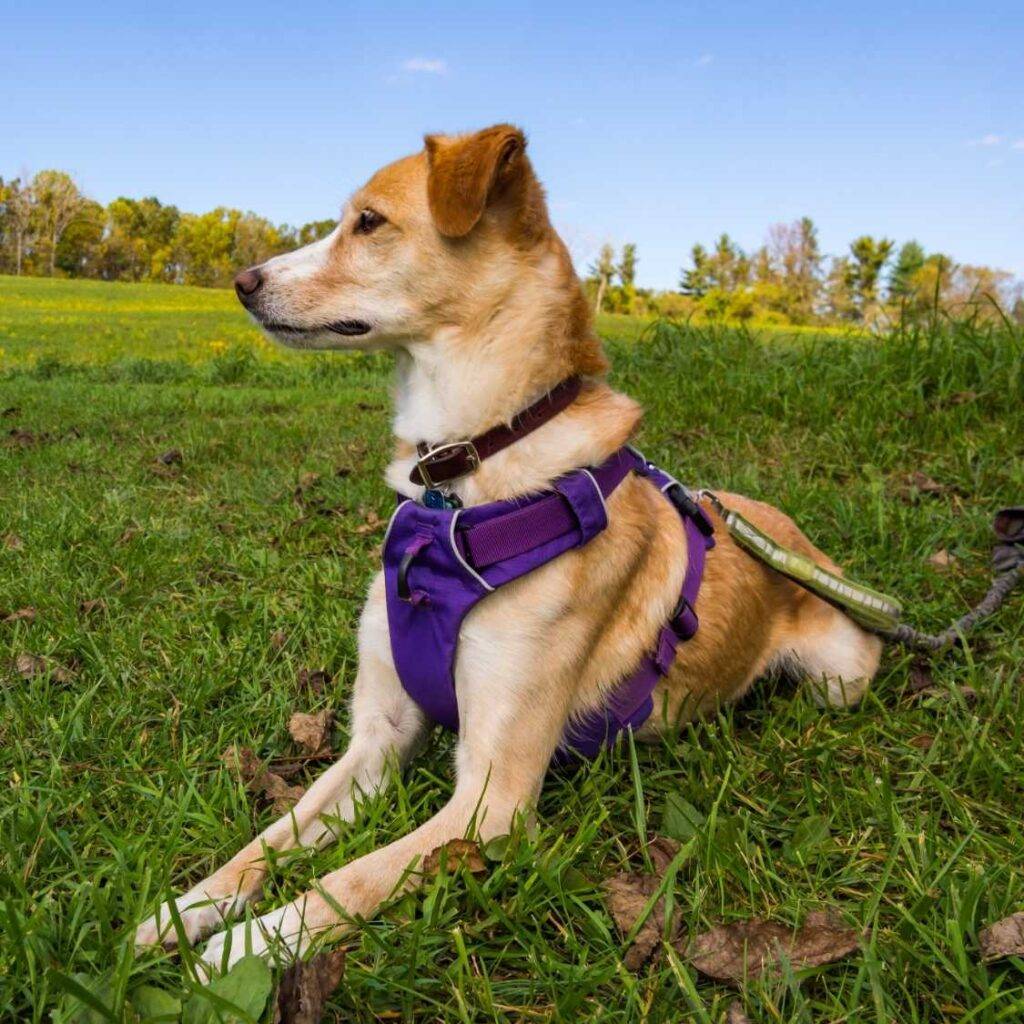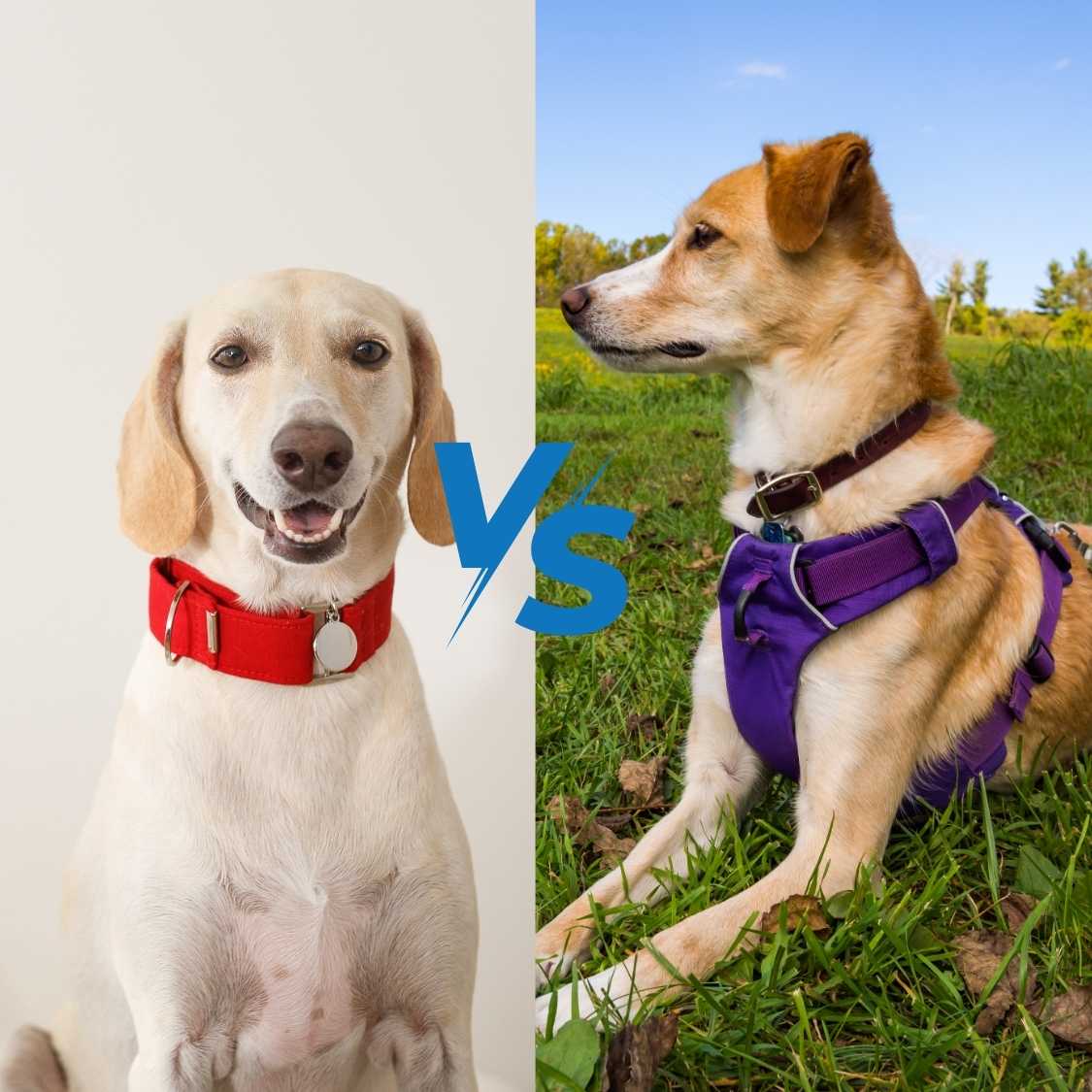Have you ever found yourself puzzled at the pet store, wondering if a harness or a collar is better for your dog?
You’re not alone! Many pet owners face this dilemma, unsure of which option will best suit their furry friend. In this blog, we’ll dive into the pros and cons of dog harnesses and collars, providing you with all the information you need to make an informed decision. Whether you’re concerned about your dog’s comfort, safety, or training needs, we’ve got you covered. By the end of this post, you’ll have a clear understanding of which accessory will work best for your canine companion.
Understanding Dog Collars

A dog collar is a piece of equipment worn around a dog’s neck. It typically consists of a strap made of various materials like nylon, leather, or fabric, and often features a buckle or a quick-release clasp for fastening. Dog collars serve several purposes, including holding identification tags, attaching leashes for walks, and as a means of control during training. They come in different types, such as flat collars, martingale collars, choke chains, and prong collars, each designed for specific uses and training purposes. Overall, dog collars are essential accessories that help keep dogs safe, secure, and properly identified.
Types of Dog Collars
Flat Collars: These are the most common and standard types of dog collars. They come in various materials, such as nylon, leather, or fabric, and typically have a buckle or quick-release clasp.
- Ideal For: Everyday use and identification purposes.
Martingale Collars: Designed with a limited-slip feature to prevent dogs from slipping out of the collar. They tighten slightly when the dog pulls but stop tightening before causing harm.
- Ideal For: Dogs with narrow heads, like Greyhounds, and those prone to slipping out of regular collars.
Choke Chains and Prong Collars: These collars are designed for training purposes, tightening around the dog’s neck when they pull. Choke chains are metal links, while prong collars have metal prongs that press into the dog’s neck.
- Ideal For: Short-term training under professional guidance due to their controversial nature.
Benefits of Dog Collars
- Easy to Put On and Take Off: Quick to secure and remove, making them practical for daily use.
- Convenient for Attaching ID Tags and Licenses: Provides a straightforward way to display identification, contact information, and licenses.
- Suitable for Dogs That Walk Calmly Without Pulling: Ideal for well-trained dogs to walk on a leash without excessive pulling.
Drawbacks of Dog Collars
- Potential Risk of Neck and Throat Injuries: This can cause harm if the dog pulls too hard or the collar is not fitted correctly, leading to neck strain or tracheal damage.
- Less Effective Control Over Strong or Reactive Dogs: Offers limited control for dogs that are strong, energetic, or reactive, potentially making walks more challenging and less safe.
Understanding Dog Harnesses

A dog harness is worn by a dog that wraps around the body and distributes pressure more evenly compared to a collar. It typically consists of straps that go around the dog’s torso and chest, along with attachment points for a leash. Dog harnesses come in various styles, including back-clip, front-clip, dual-clip, no-pull, and step-in harnesses, each serving different purposes and providing varying levels of control. Harnesses are often used as alternatives to collars, especially for dogs that pull on the leash or have neck or throat sensitivities. They are also favored for dogs with respiratory issues or those prone to slipping out of collars. Overall, dog harnesses offer a more comfortable and secure option for walking and training dogs.
Types of Dog Harnesses
Back-Clip Harnesses: These harnesses have a D-ring on the back for leash attachment. They are the most common type and are great for everyday walks.
- Ideal For: Small to medium-sized dogs and well-behaved walkers.
Front-Clip Harnesses: The leash attaches to a ring on the chest. This design helps redirect a dog’s attention back to the owner when they pull.
- Ideal For: Training purposes and reducing pulling.
Dual-Clip Harnesses: These harnesses feature attachment points on both the front and the back, offering versatility for training and regular walks.
- Ideal For: Dogs transitioning from training to regular walks or those needing more control.
No-Pull Harnesses: Specifically designed to discourage pulling, these harnesses often have multiple attachment points and may include front-clip options.
- Ideal For: Strong or reactive dogs that tend to pull on the leash.
Step-In Harnesses: Dogs step into these harnesses, which are then secured with buckles on the back. They are easy to put on and take off.
- Ideal For: Dogs that are uncomfortable with having a harness put over their head.
Benefits of Using Dog Harnesses
- Distributes Pressure Across the Dog’s Body: Unlike collars, harnesses spread the pressure over a larger area, reducing strain on the neck and throat.
- Better Control, Especially for Strong or Reactive Dogs: Provides more leverage and control, making it easier to manage dogs that pull or react to stimuli.
- Reduces Risk of Neck and Throat Injuries: By avoiding pressure on the neck, harnesses help prevent injuries related to pulling or sudden movements.
Drawbacks of Using Dog Harnesses
- Can Be More Complicated to Put On: Some harnesses have multiple straps and buckles, which can be confusing and time-consuming to fit properly.
- Some Dogs May Find Harnesses Uncomfortable at First: It may take time for a dog to get used to wearing a harness, especially if they are accustomed to collars.
- Potential for Chafing if Not Fitted Properly: An ill-fitting harness can cause chafing or irritation, so proper sizing and adjustment are crucial.
Dog Collars Vs Dog Harnesses

Control and Handling
Collars:
- Advantages: Provide straightforward control, making them suitable for basic obedience training and dogs that walk calmly without pulling.
- Disadvantages: Less effective for managing strong or reactive dogs, as they offer limited control over pulling or sudden movements.
Harnesses:
- Advantages: Offer superior control, particularly for dogs that pull, are reactive, or require training. They help distribute pressure evenly across the dog’s body, making it easier to manage strong dogs.
- Disadvantages: Can be more cumbersome to put on and adjust compared to collars.
Comfort and Safety
Collars:
- Advantages: Simple and convenient, easy to put on and take off.
- Disadvantages: This can cause neck and throat injuries, especially in dogs that pull excessively or lunge. Risk of tracheal damage in small breeds or brachycephalic (short-nosed) breeds.
Harnesses:
- Advantages: Generally safer as they distribute force across the dog’s body, reducing the risk of neck and throat injuries. Better for prolonged use, especially in active dogs.
- Disadvantages: May cause chafing or discomfort if not properly fitted. Some dogs may initially resist wearing a harness.
Training and Behavior
Collars:
- Advantages: Useful for training commands and quick corrections. Suitable for dogs that do not exhibit behavior issues related to pulling. Lightweight and less restrictive.
- Disadvantages: Less effective for correcting pulling behaviors and managing reactive dogs. Potential for causing discomfort during training sessions involving pulling or lunging.
Harnesses:
- Advantages: Ideal for training purposes, especially for dogs that pull or require behavior correction. No-pull harnesses can help discourage pulling. Better for positive reinforcement training as they are less likely to cause injury.
- Disadvantages: Can be more complex to use for quick corrections compared to collars.
Specific Use Cases
Small Breeds
- Recommendation: Harnesses are often recommended to prevent neck injuries, which can be common in small dogs with delicate tracheas.
Large Breeds
- Recommendation: Harnesses provide better control and distribute the weight more evenly, making it easier to manage strong dogs.
Puppies
- Recommendation: Harnesses are generally better to avoid neck injuries and aid in training, offering more control and safety during early learning stages.
Senior Dogs
- Recommendation: Harnesses offer more support and are gentler on aging bodies, reducing the risk of injury and providing extra assistance for dogs with mobility issues.
Conclusion
Choosing between a collar and a harness depends on your dog’s size, behavior, and specific needs. Both have their pros and cons, but the right choice can enhance your dog’s comfort and control during walks. For dogs that pull or are reactive, a harness is often the best choice. For well-trained, calm walkers, a collar can be perfectly adequate.
Frequently Asked Questions
1) Can a collar hurt my dog’s neck?
Yes, a collar can potentially hurt your dog’s neck, especially if they pull on the leash. The pressure exerted on the neck can lead to neck strain, tracheal damage, or even choking. It’s important to ensure that the collar fits properly and to use it responsibly during walks.
2) What type of harness is best for a dog that pulls?
For a dog that pulls, a no-pull harness or a front-clip harness is often recommended. These harnesses are designed to discourage pulling by redirecting the dog’s attention or providing gentle pressure when they pull. It’s essential to properly fit the harness and use positive reinforcement training techniques in conjunction with the harness to encourage desired walking behavior.
3) How do I know if a harness fits my dog correctly?
A properly fitting harness should be snug but not too tight. You should be able to fit two fingers comfortably between the harness and your dog’s body. Check that the straps are not digging into the skin or causing any discomfort. If the harness is too loose, your dog may slip out of it, while if it’s too tight, it can cause chafing or restrict movement.
4) Can I use a collar and a harness together?
Yes, using a collar and a harness together can provide additional security and control, especially for dogs that tend to slip out of their collar or harness. Attach the leash to both the collar and the harness for added safety during walks. However, always ensure that both the collar and harness are properly fitted and not causing any discomfort to your dog.
5) Are harnesses suitable for all dogs?
While harnesses are generally suitable for most dogs, there may be exceptions. Dogs with certain medical conditions or physical limitations may find harnesses uncomfortable or unsuitable. Additionally, some dogs may have behavioral issues or anxieties related to wearing a harness. In such cases, it’s essential to consult with a veterinarian or a professional dog trainer to determine the best option for your dog.








